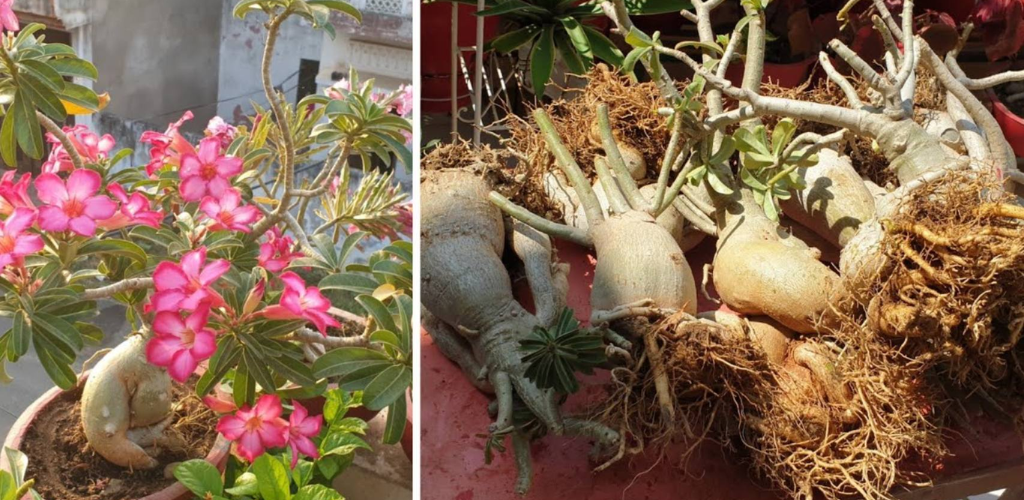How to grow Desert Rose and its care
The desert rose comes from the deserts of Africa and the Middle East. Its flowers are bright, similar to those of the oleander. It is a succulent, so it grows naturally in hot, arid areas. He does especially well when given love and attention. In this article we teach you how to grow desert rose and all the necessary care.
Summary
- Name: desert rose (Adenium obesum)
- Height: up to 2 m in the ground, but less in a pot; ideal for bonsai
- Foliage: elongated, medium green, resistant; deciduous.
- Climate : subtropical to tropical, arid; tolerates cold nights.
- Soil: Prefers well-drained, sandy soil.
- Position: sunny and open location; light shade from the midday sun
- Flowering: individual rose-like flowers in a variety of colors and combinations
- Feeding: use a long-lasting controlled release fertilizer sparingly.
- Watering: Water when conditions are warm and dry; good drainage is essential. Do not water during the dormant period.
Appearance and characteristics of the desert rose
The desert rose is a succulent, but unlike most succulents, it does not have swollen leaves. Instead, it has a swollen, belly-like trunk known as a caudex, which acts as a moisture store. It looks more like a tree than a typical succulent.
Its leaves are small and medium green. The flowers of the desert rose are very similar to those of the oleander in terms of shape. They have five equally sized and spaced petals surrounding a central yellow “eye”, each on its own short stem.
Colors range from pink to deep red, with many variations and combinations available. The size of the flowers will depend on the growing conditions, but their average size is about 5 cm.
How to grow desert rose
Growing desert rose from seeds can be tricky. The plant produces seeds after flowering, but the resulting seedlings are variable. To get a true-to-type plant, take stem cuttings when they are dormant.
The desert rose can be planted outside the garden in hot, tropical and arid climates, but it is most commonly grown in a pot or as a bonsai. It is not an “indoor” plant: it can be brought indoors for short periods while in flower, but prefers to be outside in a warm, sunny spot, away from cold winds.
If you are going to plant the desert rose bush in the garden, follow these steps:
Choose a sunny position; In tropical and arid areas, light shade from midday will protect it from burns.
Plant it so that the base of the caudex (trunk) is at or just above ground level.
The soil should be free-draining and gravelly, but richer soil will be tolerated.
Add a long-term controlled-release fertilizer during soil preparation.
If you plant the desert rose in a pot, follow these steps:
A terra cotta or porous clay pot is preferable, as it drains well and dries more quickly than plastics, ceramic, or fiberglass.
Add a shallow layer of pebbles or clay balls to the base of the pot to further improve drainage.
Use a high-quality cactus and succulent potting mix.
Place the desert rose in the pot so that the base of its caudex is at or slightly above the top of the potting mix.
Place the pot in a sheltered location for about a week to overcome the shock of transplanting, and then place it in sunlight.
Light shade starting around midday will minimize leaf scorch.
To grow desert rose as a bonsai, follow these steps:
Choose a shallow bonsai pot or bowl that is proportional to the size of the plant. Make sure the pot has enough drainage holes.
Remove the plant from the pot.
Trim the roots so that the base of the caudex is above the edge of the pot or bowl and the roots fit snugly inside the pot.
Cut a piece of metal mesh so that it fits perfectly on the base.
Holding the plant in position, fill and surround its roots with a premium bonsai potting mix.
Water well to settle the mixture.
Trim the top of the plant to start the training process.
Place the pot in a sheltered location for a few weeks before gradually introducing it into an open position.
If possible, provide light shade from midday onwards.
Desert rose care
Like other succulents, the desert rose needs regular watering, especially in hot and dry times.
“Encourage flowering using a water-soluble or liquid fertilizer in spring and summer
Once a year, a long-term controlled release fertilizer can be added around plants in the garden and pots. Again, use sparingly.
Desert Rose Pruning
When grown in the garden, the desert rose responds well to light pruning to maintain its shape. Trim only in the dry season to prevent infections from entering the cuts.
The tips of a desert rose bonsai should be trimmed every few months, but you must be aware of where the flowers come from and not trim beyond these points before the flowers have appeared.
Diseases and pests
The desert rose is reasonably disease-free, and is rarely affected by pests. If aphids or scale insects are present, a light spray with white oil or insecticidal soap can be applied.
